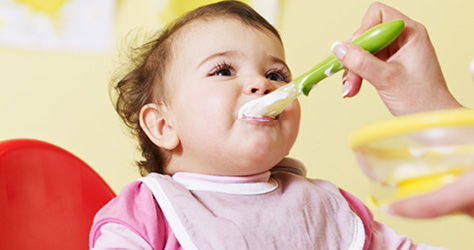Before you start your baby on those all-exciting solid foods, you’ll need to stock up on bibs, cutlery, splash mats and more.
Here’s the lowdown on weaning essentials:
At a glance
- Stock up on all the essentials before you start - it can get quite messy!
- Buy plates and bowls that stick to the table to stop them being flung around the room
- Metal spoons can hurt your baby's mouth so try small hard plastic ones instead

- Floor protector - a splash mat or wipeable plastic tablecloth to go under the highchair – weaning can be seriously messy
- Baby spoons – try small hard, plastic weaning spoons that won’t crack
- The coverall combo – try coverall bibs (with sleeves), and pelican bibs – this winning combo will hopefully catch food in a tray to protect your baby’s clothes
- Flexible ice cube trays - for freezing tiny meals of puréed food
- A blender or sieve – ideal for puréeing food
- A cooler bag - for when you’re out and about
- A camera - for capturing your baby’s wild and comic expressions when they first taste new foods!
Choosing a beaker
If you give your baby a drink with their meal, you’ll need a good beaker. Ideally, start off with a free-flow, lidded beaker rather than a non-spill beaker with a valve. This will teach your baby to sip rather than suck.
A beaker with two handles will be easier to hold at first. Then when your baby is confident drinking from a lidded beaker, you can move onto the dizzy heights of a cup!
Make sure you dodge the sugar - sweetened drinks are the biggest cause of tooth decay in young children, so make sure you only serve breast milk, formula or water.
Choosing a plate and spoon
You’ll need a plastic plate or bowl – ideally one that sticks to the table, to stop bowls being joyfully flung around the room. Or why not try putting finger foods straight on the feeding tray of the highchair? Just get it super clean first.
Metal spoons could hurt your baby’s mouth, so you’re best off with small, hard plastic weaning spoon that won’t crack. Babies love nothing better than a madly exciting, brightly-coloured spoon – it’ll help keep them interested in the food.
Don’t worry about sterilising plates, spoons, cups and highchair trays – just make sure they’re clean.
What to look for in a highchair
There’s a vast array of great highchairs on the market - just make sure your favourite offers these features:
- Good fit- to be comfortable in a highchair, your baby needs to be well supported and not slouching over with their tummy squashed
- Safety first - conforms to standards EN14988: 2006 and EN 14988-2: 2006.
- Stable – a heavyweight highchair with a wide base for stability is best. Metal or wooden frames are the most stable
- Strap-tastic - a waist strap and a strap that runs between the legs
- Soft and safe - make sure there are no sharp edges on the tray
- No loose parts – check for loose nuts and other small parts that your baby could accidently shovel in with those peas!
Table-mounted highchairs
Your baby really can join the family meal sitting up at the table with these - just make sure they’re completely safe:
- Safety standards - conforms to EN1272:1998
- Secure - use table-mounted highchairs on solid tables, not glass or single pedestal tables